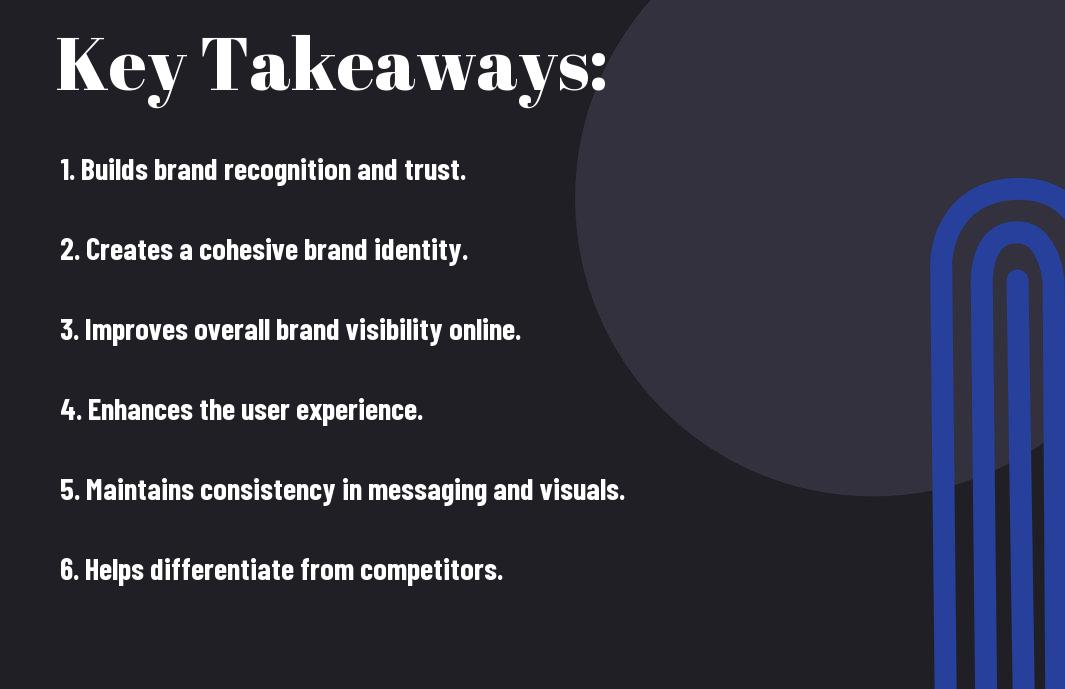With the vast digital landscape constantly evolving, maintaining consistent branding across all your online platforms is crucial for building trust and recognition with your audience. In this digital era, your brand’s image on websites, social media, and emails is often the first impression you make on potential customers. By ensuring that your brand’s messaging, visuals, and tone are consistent across all digital touchpoints, you establish a strong brand identity that engages and resonates with your target market.
Key Takeaways:
- Branding Identity: Consistent branding across all digital platforms helps establish a strong and cohesive brand identity.
- Brand Recognition: Having consistent branding elements such as colors, logo, and messaging helps in improving brand recognition among the audience.
- Customer Trust: Consistency in branding builds trust with customers, as it portrays reliability and professionalism of the brand.
The Digital Landscape
A multichannel approach to branding is no longer enough in today’s digital landscape. With the rise of new technologies and platforms, it has become important for brands to adopt an omnichannel strategy to stay relevant and competitive.
The Rise of Omnichannel Experience
Omnichannel marketing focuses on providing a seamless and consistent brand experience across all digital platforms. This means that whether you interact with a brand on social media, their website, or through an app, the messaging and branding elements will be cohesive and unified. By implementing an omnichannel approach, you can increase customer engagement, build brand loyalty, and drive conversions as you create a more integrated and personalized customer journey.
The Fragmented Consumer Journey
With the multitude of digital channels available today, consumers often have a fragmented journey as they move between different platforms and devices. This can make it challenging for brands to deliver a consistent message and experience at every touchpoint. However, by embracing an omnichannel strategy, you can overcome these challenges and ensure that your brand is present and consistent throughout the customer journey.
It is important to remember that consumers expect a cohesive experience when interacting with a brand online, and by failing to provide this, you risk losing their interest and loyalty. By implementing a consistent branding strategy across all digital platforms, you can strengthen your brand identity and create a unified experience that resonates with your audience.

Branding in the Digital Age
If you want to understand the significance of consistent branding across all digital platforms, you should explore The Importance of Brand Consistency in Digital Marketing. In today’s fast-paced and ever-evolving digital landscape, maintaining a cohesive brand identity is crucial for establishing trust and recognition with your audience.
Defining Your Brand Identity
With so many digital channels available to connect with your target market, it’s necessary to have a clear and consistent brand identity. Your brand identity is more than just a logo or color scheme; it encompasses your values, mission, and the overall experience you provide to your customers. By clearly defining your brand identity, you can create a strong and memorable impression that resonates with your audience across all digital platforms.
The Importance of Consistency
For your brand to stand out in the digital age, consistency is key. **Consistency** in your messaging, visuals, and tone helps **establish** a sense of **trust** and **reliability** with your audience. When **you** present a **consistent** image across all online touchpoints, **you** reinforce **your brand’s** identity and **build** a **strong** connection with **your** customers. **Your** audience **is** more likely to **remember you** and **choose you** over **competitors** when they **encounter consistent** branding that **resonates** with **them**.

The Consequences of Inconsistent Branding
Once again, it cannot be stressed enough how crucial it is for your brand to maintain a consistent image across all digital platforms. As discussed in The Power Of Consistent Branding Across Digital Platforms, deviating from a unified brand identity can have severe repercussions for your business.
Confusion and Dilution of Brand Message
With inconsistent branding, confusion reigns supreme. Your audience may struggle to grasp your core values, products, or services when they are portrayed differently on various digital channels. This dilution of your brand message can lead to a fragmented brand image, which jeopardizes your brand’s ability to resonate with your audience.
Loss of Trust and Credibility
On the path of inconsistent branding lies the treacherous downfall of trust and credibility. When your audience encounters conflicting brand messages or visuals, **they may begin to question the authenticity and reliability of your brand**. This erosion of trust can drive potential customers away and damage the relationships you have worked so hard to build.
Dilution in branding efforts can result in lost opportunities to connect with your target audience and establish long-lasting relationships based on trust and credibility. Your brand’s reputation is delicate, and any inconsistencies can chip away at the trust you’ve built with your customers.
Inefficiency in Resource Allocation
Message consistency is also crucial for streamlining your marketing efforts and allocating resources efficiently. When your branding is inconsistent across different digital platforms, it **becomes challenging to track and measure the effectiveness of your marketing campaigns**. This lack of cohesiveness can lead to wastage of resources as you struggle to identify which strategies are yielding results and which ones are falling short.
Inconsistent branding not only hampers your ability to analyze the impact of your marketing activities but also **hinders your capacity to optimize your resources effectively**. By maintaining consistent branding across all digital platforms, you can ensure that your efforts are focused and yield the desired results.
Building a Strong Online Presence
Unlike traditional brick-and-mortar stores, your online presence is crucial for reaching a wide audience and establishing your brand. Consistency across all digital platforms is key to creating a strong and recognizable brand identity. When your audience sees the same messaging, visuals, and tone across your website, social media, and content, it builds trust and loyalty.
Website: The Central Hub of Your Brand
Your website is the central hub of your brand’s online presence. It’s where customers go to learn more about your products or services, make purchases, and engage with your brand. Ensuring your website reflects your brand’s values, aesthetics, and messaging is vital for creating a cohesive online experience for your customers. From the logo and color scheme to the tone of voice used in the content, every element of your website should align with your brand identity.
Social Media: Extending Your Reach
An engaging social media presence is vital for extending your brand’s reach and connecting with your target audience. Platforms like Facebook, Instagram, Twitter, and LinkedIn allow you to interact with customers in real-time, share updates and promotions, and showcase your brand’s personality. By maintaining a consistent brand voice and visual style across all social media channels, you reinforce your brand identity and increase brand recognition.
Strong social media engagement can also help you build a loyal community of followers who advocate for your brand and share your content, further expanding your online presence.
Content Strategy: Telling Your Story
Your content strategy is a powerful tool for telling your brand’s story and connecting with your audience on a deeper level. Whether it’s through blog posts, videos, podcasts, or social media posts, your content should reflect your brand’s values and communicate your unique selling proposition. By creating high-quality, relevant content that resonates with your target audience, you can establish your brand as a thought leader in your industry and build credibility and trust with your customers.
PresenceConsistently sharing valuable and engaging content helps you stay top-of-mind with your audience and drive traffic to your website, ultimately contributing to a strong online presence that sets you apart from your competitors.
Visual Identity and Design Elements
Logo, Color Palette, and Typography
Color plays a crucial role in creating a strong visual identity for your brand. Your logo, color palette, and typography should all work together cohesively to reflect your brand’s personality and values. Consistency in color usage across all digital platforms helps in instant brand recognition and builds trust with your audience.
Imagery and Iconography
Iconography is another vital element of your visual identity. Using consistent imagery and icons that align with your brand’s aesthetics helps reinforce brand messaging and creates a memorable visual experience for your audience. Icons can be powerful tools to communicate ideas quickly and effectively, so it’s crucial to maintain consistency in their design and usage.
Visual elements such as photos, illustrations, and graphics also play a significant role in conveying your brand’s story and connecting with your audience on an emotional level. Choosing the right imagery that resonates with your brand values and maintaining a consistent visual style can enhance brand recall and leave a lasting impression on your audience.
Consistency Across Platforms
Imagery should be consistent across all your digital platforms, including your website, social media profiles, and digital marketing materials. By ensuring that your visual assets maintain the same look and feel across different platforms, you create a unified brand experience for your audience. This consistency reinforces your brand identity and helps establish credibility and trust with your customers.
Consistency in your visual identity and design elements not only strengthens brand recognition but also helps in building a cohesive brand image that resonates with your target audience. Whether someone interacts with your brand on social media or visits your website, maintaining a consistent visual identity across all digital platforms ensures a seamless brand experience and establishes a strong brand presence in the digital space.
Tone, Voice, and Language
Developing a Unique Tone and Voice
Now, when it comes to branding across digital platforms, one of the key components to focus on is developing a unique tone and voice for your brand. **Consistency** in tone and voice helps in creating a recognizable brand identity. Think about how you want your brand to come across to your audience – is it friendly, professional, humorous, or authoritative? This decision will shape the way you communicate with your audience across all platforms.
Language and Messaging Consistency
To maintain a **consistent** brand image, it’s necessary to ensure that your language and messaging are uniform across all your digital platforms. **Consistency** in language helps in reinforcing your brand values and messaging. Your audience should be able to recognize your brand simply by the way you communicate with them, whether it’s through social media posts, website content, or email newsletters.
Consistency in language not only helps in brand recognition but also builds trust with your audience. When your messaging is clear and consistent, it shows that you are a reliable and professional brand that pays attention to details.
Emotional Connection with Your Audience
Unique digital communication has the power to create an emotional connection with your audience. By staying true to your brand’s tone, voice, and language, you can resonate with your audience on a deeper level. **Consistency** in emotional messaging helps in building loyalty and trust with your customers, as they feel understood and valued by your brand.
On Emotional Connection with Your Audience
With a strong emotional connection, your audience is more likely to engage with your content, share it with others, and become loyal customers. By creating **unique** emotional bonds through your digital platforms, you can turn casual followers into brand advocates who will support your business enthusiastically.
Conclusion
From above, it is evident that maintaining consistent branding across all digital platforms is crucial for your business’s success. By presenting a unified brand image, you establish trust and credibility with your audience while also enhancing brand recognition. This consistency helps to create a strong brand identity that resonates with your customers and sets you apart from competitors.
Be mindful of, in today’s fast-paced digital world, your customers interact with your brand across various platforms and devices. Ensuring that they receive a consistent brand experience at every touchpoint can lead to increased loyalty, engagement, and ultimately, more conversions. So, make it a priority to align your messaging, visuals, and tone across all digital platforms to build a strong and recognizable brand that stands out in the crowded online landscape.